Contents
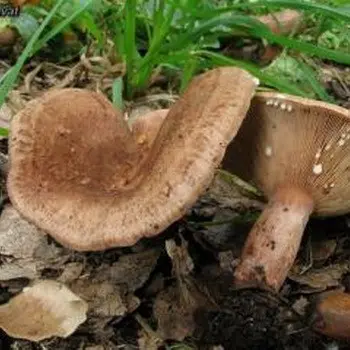 Mlechnik is a conditionally edible mushroom of the Russula family. Lactic mushrooms owe their name to the content in the pulp of vessels with milky juice, which flows out when the fruiting body is damaged. In older specimens and in dry seasons, the milky sap dries up and may be absent.
Mlechnik is a conditionally edible mushroom of the Russula family. Lactic mushrooms owe their name to the content in the pulp of vessels with milky juice, which flows out when the fruiting body is damaged. In older specimens and in dry seasons, the milky sap dries up and may be absent.
Below is a photo and description of the lactic fungus of various types (faded, ordinary, orange, brown, brownish, hygrophoric, pungent, caustic, orange and stunted).
Milky mushroom ordinary and his photo
Category: conditionally edible.
Common lactic cap (Lactarius trivialis) (diameter 5-22 cm): shiny even in dry weather, with dark rings. It changes color and shape depending on the age of the fungus: in young mushrooms it is dark and gray-gray, rather convex; in old ones it is lilac and brown, and then ocher or yellow, flatter and even depressed. Dense, may be with small dimples. The edges are wavy, curved, often wrapped inward.
Leg (height 4-10 cm): pale gray or light ocher, cylindrical, sometimes swollen, but always hollow. A little slimy and sticky.
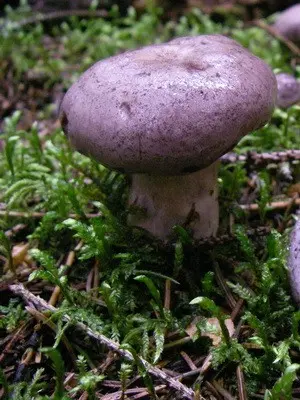
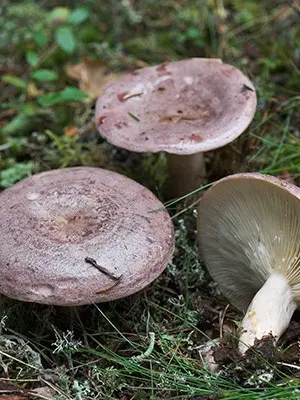
Pay attention to the photo of an ordinary lactic: its plates are frequent, thin (occasionally wide), mostly yellow or cream in color, with rusty spots.
Pulp: thick and fragile. Mostly white, but brownish under the skin, and reddish at the base. Milky juice is very bitter, when interacting with air it changes color to yellow or slightly greenish. It has a peculiar smell, reminiscent of fish.
[ »»]
Doubles: are absent.
When growing: from mid-July to the end of September.
Where can I find: in damp places and lowlands of all types of forests, most often near pines, spruces and birches. Hiding in thick grass or moss. An ordinary milkman is not afraid of insect pests.
Eating: fresh or salted, subject to pre-soaking to remove bitterness. When cooked, it changes color to bright yellow or orange. It is very popular in blanks with the hostesses of Finland.
Application in traditional medicine: does not apply.
Other names: smooth, alder, hollow, yellow hollow, gray breast.
Milky faded: photo and application
Category: conditionally edible.
Faded lactic cap (Lactarius vietus) (diameter 4-9 cm): gray, lilac, lilac or gray-brown, fading to white or grayish with time. Slightly convex or prostrate. The center is slightly depressed, but with a slight tubercle and is usually darker than the edges wrapped towards the inside. The surface is often uneven. Feels sticky and moist, with sticky twigs or leaves.

As you can see in the photo, the faded milky has a smooth, sometimes slightly curved leg. Its height is 5-9 cm. The color is white or light brown, lighter than the cap. The shape is cylindrical.
Records: thin, narrow and very frequent. Cream or ocher in color, gray at the point of pressing.
Pulp: white or gray, with caustic milky juice. Thin, very fragile.
Doubles: are absent.
When growing: mid-August to early October.
Where can I find: in deciduous and mixed forests, especially often near birches. Prefers damp and marshy places.
The use of faded milkweed in cooking is limited – since the pulp of the mushroom is very thin, it is not very popular. Salt and marinate only the largest specimens.
Application in traditional medicine: does not apply.
Other names: milky sluggish, swamp wave.
Edible milky mushroom brownish
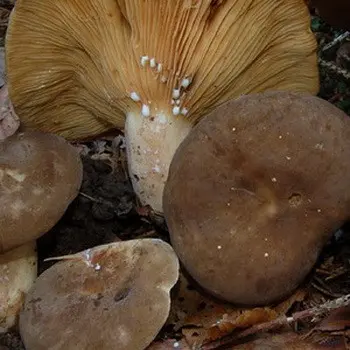 Category: conditionally edible.
Category: conditionally edible.
Brown milk cap (Lactarius fuliginosus) (diameter 5-12 cm): brown or dark chocolate, brittle, changes shape from convex to strongly depressed. The edges are usually folded over. Velvety to the touch.
Leg (height 5-11 cm): white or light brown, but always white at the base. Cylindrical, velvety to the touch.
Records: frequent, have a pinkish or buffy hue.
Pulp: fragile and whitish, turning pink when cut and exposed to air. It has a sharp, but not bitter taste, freshly cut mushrooms have a distinct fruity aroma.
Doubles: brown milkweed (Lactarius lignyotus), which has a darker cap and a longer stem.
When growing: from early July to mid-September in the forests of Europe.
Where can I find: in deciduous forests next to oaks and beeches.
The brownish milky mushroom is considered edible due to the fact that it is more often eaten than other species. This mushroom is dried and salted, but only after careful heat treatment. In Our Country, it is a traditional component of pickles, and the inhabitants of Western Europe consider it unsuitable for human consumption.
Application in traditional medicine: does not apply.
Other names: milky sooty, milky dark brown.
[ »wp-content/plugins/include-me/ya1-h2.php»]
Fungus milkweed
Category: conditionally edible.
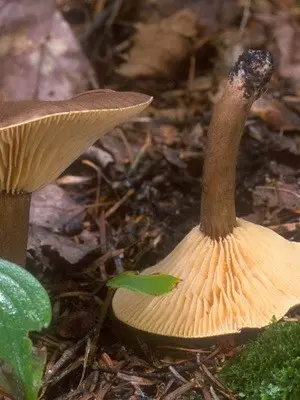
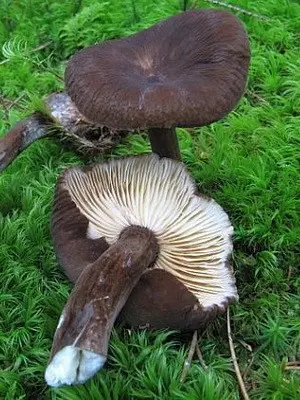
Brown lactic cap (Lactarius lignyotus) (diameter 3-9 cm): dark chestnut or black-brown. In young mushrooms, it is convex, often with a small tubercle in the center. Over time, it becomes prostrate, and later depressed. Velvety to the touch, occasionally with a small amount of wrinkles. The edges are always wavy and slightly pubescent.
[ »wp-content/plugins/include-me/goog-left.php»]
Leg (height 4-10 cm): hard and solid, cylindrical in shape, often of the same color with a hat or a little lighter. Velvety to the touch.
Records: wide, firmly attached to the hat. Usually white, in old mushrooms slightly yellowish, when pressed, they acquire a distinct reddish tint.
Pulp: white or light yellow in color, on the cut it acquires a reddish tint. The milky juice is watery and non-caustic. There is no pronounced smell and taste, although almost all related mushrooms have a pleasant aroma.
Doubles: tarry black (Lactarius picinus) and brownish (Lactarius fuliginosus) milkers. But the resinous black can be distinguished by its extremely caustic milky juice and the lighter color of the stem, while the brownish one grows exclusively in deciduous forests.
When growing: from the beginning of August to the end of September in the countries of the Eurasian continent with a temperate climate and the Asian part of Our Country.

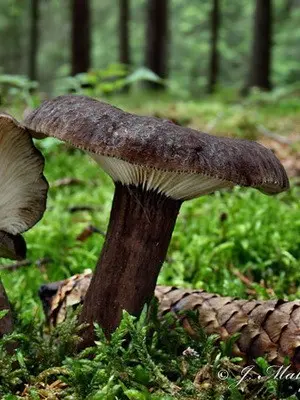
Where can I find: brown milkweed can be found on acidic soils of coniferous forests.
Eating: only caps (the legs are very hard), which are usually pickled or pickled.
Application in traditional medicine: does not apply.
Other names: moor-headed breast, wood lactiferous.
Edible mushroom lactarius hygrophoroides (Lactarius hygrophoroides)
Category: edible.
Hat (diameter 4-10 cm): predominantly brown, sometimes with a brown or reddish tinge. In young mushrooms, it is slightly convex or flat, while in older mushrooms it is slightly depressed. Dry to the touch.
The leg of the lactarius hygrophoroid (Lactarius hygrophoroides) (height 3-8 cm): dense, slightly lighter than the cap.
Records: descending and rare, white or light cream.
Pulp: very brittle, white, with white milky juice.
Doubles: red-brown breast (Lactarius volemus), in which, in contrast to the hygrophoroid, the milky juice changes color from white to brownish.
When growing: from the end of June to mid-October in the countries of the Eurasian continent with a temperate climate.
Where can I find: hygrophorous milkweed can only be found in deciduous forests, most often near oaks.
Eating: fried, salted and pickled.
Application in traditional medicine: does not apply.
Milky milky mushroom (Lactarius pyrogalus)
Category: conditionally edible.

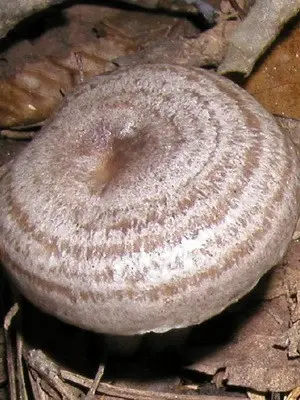
Hat (diameter 4-7 cm): from flesh to olive or cream. In young mushrooms it is rounded with a pronounced apex, in mature mushrooms it is concave with slightly wavy edges. Covered with mucus, the amount of which increases significantly in wet weather and after rain.
Leg (height 3-7 cm): similar in color to the hat, dense and slightly narrowed. Old mushrooms can be completely hollow.
Records: light yellow, rare and thick.
Pulp: dense, off-white or light gray. When broken, it emits a very pleasant mushroom smell. The taste is pungent, which is why the mushroom got its name.
Twins of the milky milky (Lactarius pyrogalus): lactarius faded (Lactarius vietus), hornbeam (Lactarius circellatus), neutral (Lactarius quietus) and sharp (Lactarius acris). Faded can be distinguished by the purple tint of the cap and the neighbor tree (grows under birches), and the hornbeam grows exclusively under hornbeams. The neutral lactic has a pungent odor and a darker cap color. The spicy milky juice turns red in the air, while the juice of the burning red milky is white or light yellow and does not darken.
Milky-burning milky grows from mid-August to early October in many countries of Europe and Asia.
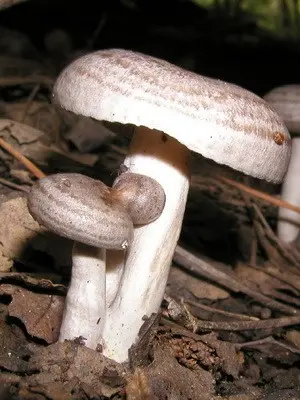
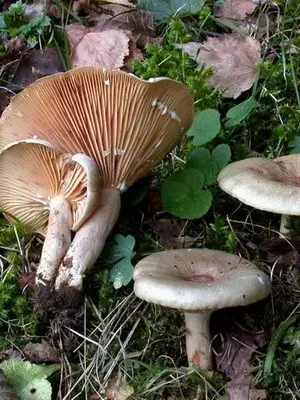
Where can I find: in deciduous forests, mostly near hazel, or dense shrubs. Prefers lighted areas of the forest. You will never find a burning milky milky in dark and wet lowlands.
Eating: only in salted form.
Application in traditional medicine: does not apply.
Other names: burning lactic, garden lactic.
Milky mushroom orange and his photo
Category: conditionally edible.
Orange milkweed cap (Lactarius mitissimus) (diameter 4-12 cm): usually orange or deep apricot, very fine. In young mushrooms, it is slightly convex or flat, eventually changing to funnel-shaped.
Leg (height 3-11 cm): cylindrical shape, the same color with a hat. In young mushrooms, it is dense, often becoming hollow with time.
Records: not very frequent, cream color.
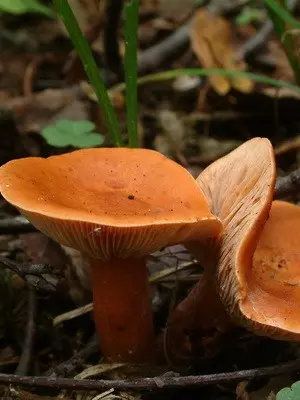
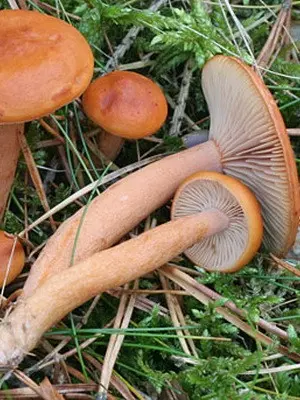
If you look closely at the photo of the orange lactic, you can see bright red spots on its plates.
Pulp: dense, usually light orange. It does not have a pronounced smell and taste.
Doubles: the young milky is brownish (Lactarius fuliginosus), but it has a darker cap color and a long stem.
When growing: from mid-July to early October in the countries of the Eurasian continent with a temperate climate.
Where can I find: non-caustic milkweed is found by mushroom pickers in forests of various types, usually near oaks, spruces and birches. It can burrow very deep into the moss bedding.
Eating: usually salted or pickled.
Application in traditional medicine: does not apply.
Other names: lactic acid is not edible.
[ »]
Conditionally edible milky mushroom stunted
Category: conditionally edible.
Milky cap (Lactarius tabidus) (diameter 3-7 cm): red, orange or brick. In young mushrooms it is convex and with a small tubercle in the center, in mature mushrooms it is prostrate or even slightly depressed.
Leg (height 2-6 cm): the same color or slightly lighter than the cap.
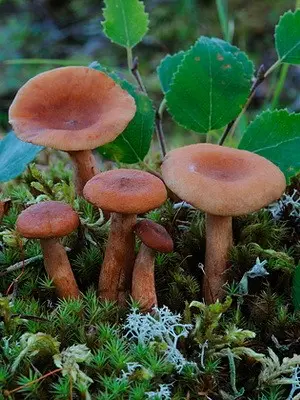
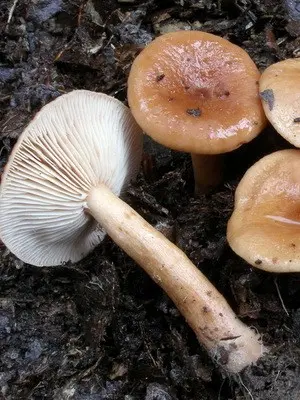
Pay attention to the photo of the lactic mushroom at a young age – their leg is slightly loose, over time it becomes completely hollow.
Records: quite rare, the same color as the cap, but slightly lighter.
Pulp: white or slightly yellowish, with a spicy taste. Milky juice is also white, but darkens noticeably when dried.
Doubles: rubella (Lactarius subdulcis), the milky juice of which does not change color.
When growing: from mid-July to early September.
Where can I find: stunted milkweed is met by mushroom pickers in wet places of deciduous and mixed forests.
Eating: only fried.
Application in traditional medicine: does not apply.
Other names: soft milky.









